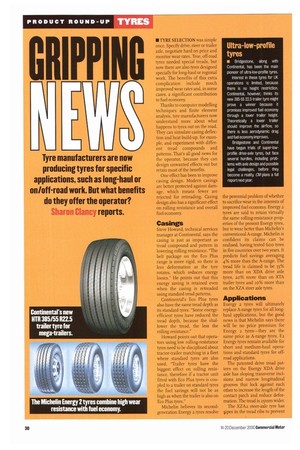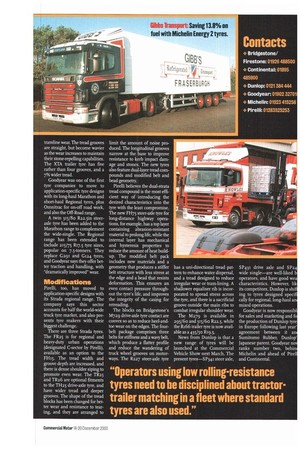GRIPPING
Page 32

Page 33

If you've noticed an error in this article please click here to report it so we can fix it.
• TYRE SELECTION was simple once. Specify drive, steer or trailer axle, negotiate hard on price and monitor wear rates. True, off-road tyres needed special treads, but now there are also tyres designed specially for long-haul or regional work. The benefits of this extra complication include much improved wear rates and, in some cases, a significant contribution to fuel economy.
Thanks to computer modelling techniques and finite element analysis, tyre manufacturers now understand more about what happens to tyres out on the road. They can simulate casing deflection and heat build-up, for example, and experiment with different tread compounds and patterns. That's all good news for the operator, because they can design unwanted effects out but retain most of the benefits.
One effect has been to improve casing design. Modern casings are better protected against damage, which means fewer are rejected for retreading. Casing design also has a significant effect on rolling resistance and overall fuel economy.
Casings
Steve Howard, technical services manager at Continental, says the casing is just as important as tread compound and pattern in lowering rolling resistance. "The belt package on the Eco Plus range is more rigid, so there is less deformation as the tyre rotates, which reduces energy losses." He points out that this energy saving is retained even when the casing is retreaded using standard tread patterns.
Continental's Fe° Plus tyres also have the same tread depth as its standard tyres. "Some energyefficient tyres have reduced the tread depth, because the shallower the tread, the less the rolling resistance."
Howard points out that operators using low rolling-resistance tyres need to be disciplined about tractor-trailer matching in a fleet where standard tyres are also used. "Trailer tyres have the biggest effect on rolling resistance, therefore if a tractor unit fitted with Eco Plus tyres is coupled to a trailer on standard tyres the fuel savings will not be as high as when the trailer is also on Eco Plus tyres."
Michelin believes its secondgeneration Energy 2 tyres resolve
the perennial problem of whether to sacrifice wear in the interests of improved fuel economy. Energy 2 tyres are said to retain virtually the same rolling-resistance properties of the present Energy tyres, but to wear better than Michelin's conventional A-range. Michelin is confident its claims can be realised, having tested Goo tyres in five countries over two years. It predicts fuel savings averaging 4% more than the A-range. The tread life is claimed to be 35% more than on XDA drive axle tyres. 20% more than on XTA trailer tyres and to% more than on the XZA steer axle tyres.
Applications
Energy a tyres will ultimately replace A-range tyres for all longhaul applications, but the good news is that Michelin says there will be no price premium for Energy a tyres—they are the same price as A-range tyres. Ea Energy tyres remain available for short and medium-haul operations and standard tyres for offroad applications.
The patented drive tread pattern on the Energy XDA drive axle has sloping transverse incisions and narrow longitudinal grooves that lock against each other to increase the length of the contact patch and reduce deformation. The tread is 25mm wider.
The XZA2 steer-axle tyre has 4ipes in the tread ribs to prevent tramline wear. The tread grooves are straight, but become wavier as the wear increases to maintain their stone-repelling capabilities. The XTA trailer tyre has five rather than four grooves, and a 7% wider tread.
Goodyear was one of the first tyre companies to move to application-specific tyre designs with its long-haul Marathon and short-haul Regional tyres, plus Omnitrac for on-off road work, and also the Off-Road range.
A twin 315/80 R22.5in steeraxle tyre has been added to the Marathon range to complement the wide-single. The Regional range has been extended to include 215/75 R17.5 tyre sizes, popular on 7.5-tonners. They replace G291 and Gi24 tyres, and Goodyear says they offer better traction and handling, with "dramatically improved" wear.
Modifications
Pirelli, too, has moved to application-specific designs with its Strada regional range. The company says this sector accounts for half the world-wide truck tyre market, and also presents tyre makers with their biggest challenge.
There are three Strada tyres. The FR25 is for regional and heavy-duty urban operations (designated C-sector by Pirelli), available as an option to the FI-115. The tread width and groove depth are increased, and there is dense shoulder siping to promote even wear. The TR25 and TR26 are optional fitments to the TH25 drive-axle tyre, and have wider tread and deeper grooves. The shape of the tread blocks has been changed for better wear and resistance to tearing, and they are arranged to limit the amount of noise produced. The longitudinal grooves narrow at the base to improve resistance to kerb impact damage and stones. The new tyres also feature dual-layer tread compounds and modified belt and bead geometry.
Pirelli believes the dual-strata tread compound is the most efficient way of introducing the desired characteristics into the tyre with the least compromise. The new FH75 steer-axle tyre for long-distance highway operations, for example, has a top layer containing abrasion-resistant material to prolong life, while the internal layer has mechanical and hysteresis properties to reduce the amount of heat buildup. The modified belt pack includes new materials and a geometry that produces a stiffer belt structure with less stress at the edge and a bead that resists deformation. This ensures an even contact pressure throughout the tyre's life, and improves the integrity of the casing for retreading.
The blocks on Bridgestone's M729 drive-axle tyre contact are convex so as to reduce heel-andtoe wear on the edges. The fourbelt package comprises three belts for stiffness and a wavy belt, which produce a flatter profile and reduce the wandering of truck wheel grooves on motorways. The R227 steer-axle tyre has a uni-directional tread pattern to enhance water dispersal, and a tread designed to reduce irregular wear or tram-lining. A shallower equaliser rib is incorporated to spread stress across the tyre, and there is a sacrificial groove outside the main ribs to combat irregular shoulder wear.
The M279 is available in 295/60 and 315/60 R.22.5, while the R166 trailer tyre is now available as a 435/50 R19.5.
News from Dunlop is that a new range of tyres will be launched at the Commercial Vehicle Show next March. The present tyres—SP341 steer axle, SP431 drive axle and SP2 wide single—are well-liked b operators, and have good we characteristics. However, lik its competitors, Dunlop is shi ing to tyres designed speci cally for regional, long-haul an mixed operations.
Goodyear is now responsibl for sales and marketing and f the production of Dunlop tyr in Europe following last year' agreement between it an Sumitomo Rubber, Dunlop' Japanese parent. Goodyear no ranks number two, behin Michelin and ahead of Pirel and Continental.




































































































